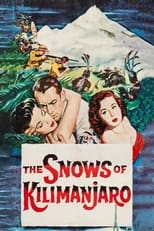Wuchak
Sep 22, 2020
6/10
An agglomeration of Hemmingway stories with Peck, Hayward and Gardner
In the shadow of Mt. Kilimanjaro, a wounded writer (Gregory Peck) deliriously reflects on his past loves & adventures in Paris, the French Riviera and Spain during the Spanish Civil War.
“The Snows of Kilimanjaro” (1952) is a melodramatic drama/romance/adventure, the quaint blueprint for future flicks like “Legends of The Fall” (1994). It’s an assemblage of several unrelated Hemmingway stories, including the title one (obviously), as well as his nonfiction book Death in the Afternoon (1932).
The Peck character, Harry Street, is basically a fictional version of Hemingway, who was an author/journalist attracted to traveling, adventure, war and women. He was a volunteer ambulance driver in Italy during WW1 where he was wounded by shrapnel in both legs, which is depicted in the well done “In Love and War” (1996). As a journalist, he was in Spain during much of the Spanish Civil War (1936-1939), hunted on safaris in Africa and was fascinated by bullfighting in Spain & Mexico.
Harry Street comes across as a self-absorbed drama queen who treats gorgeous women dubiously. But the African scenery helps assuage some of the monotony, like the hippos on the river, but the rhinoceros killing is painful to watch because I hate the unnecessary killing of animals, especially mighty ones who could easily kick the hunter’s axx if he didn’t have a rifle.
If you’re not in the right mode, this can be a ponderously episodic bore. But it’s rescued by featuring two of Hollywood's most beautiful ladies, Susan Hayward and Ava Gardner, not to mention Hildegard Knef. Susan’s pal, Hedy Lamarr, was originally offered the role Ava eventually took.
The film runs 1 hour, 54 minutes and was shot in Nairobi, Kenya; Cairo, Egypt; and the French Riviera; as well as 20th Century Fox Studios, Century City, Los Angeles.
GRADE: B-/C+
